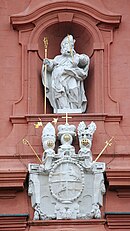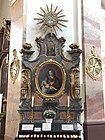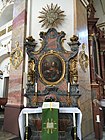Parish Church of St. Blasius (Fulda)
The Catholic parish church of St. Blasius was built between 1771 and 1785 in the Baroque style according to the plans of the Jesuit brother Johann Andreas Anderjoch. It is the home of the St. Simplicius, Faustinus and Beatrix inner city parish founded in 2015.
history
After the Fulda Monastery was founded , craftsmen and merchants settled around the monastery. During this time, around 950 AD, the first parish church was built, which was probably placed under the patronage of Mauritius and was surrounded by a cemetery.
After a fire in 1103 a new church was built in the Romanesque style, which consisted of a nave, a transept, a choir square and a semicircular apse. St. Blaise is attested as their patronage in 1221 .
In the period from 1447 to 1470 a parish church was built in the Gothic style. Today's north-west tower (left bell tower) dates from this time, and some remains of this time can still be seen inside.
During the Reformation Adam Krafft preached the new teaching, which did not prevail. During the period from the Hessian occupation of Fulda up to the Counter-Reformation , Protestant services were held in the parish church.
In 1771, under Prince-Bishop Heinrich von Bibra, the old church was torn down and the construction of a late Baroque parish church began. The plans for this come from the Jesuit priest Andreas Anderjoch . The consecration took place on August 18, 1785 on the patronage of Blasius . In 1837 a new organ was purchased, which was renewed in 1901.
architecture
The parish church consists of three naves , the central nave is optically separated by the adjacent supporting pillars. It also has two sacristy extensions to the right and left of the chancel.
Towers
The two towers are on the west side. The northern one has the function of the bell tower. In the south tower, which dates from the Baroque era, is the apartment of the former tower keeper of the city of Fulda, which was in use until his death in 1822 and can be reached via 162 stairs. Both towers each have a square platform with a walkway and two lanterns and are 53.60 m high.
outer facade
Between the two towers, the central nave is closed off by the protruding west facade with the main portal . The Fulda city coat of arms is located above the wooden portal . Above it is a round window and the coat of arms of the former Fulda prince-bishop Heinrich von Bibras . Under the blue clock with a golden face is a stone sculpture of St. Blaise .
Central nave
In the inner nave there are four arcades to the left and right , above which images of eight apostles can be seen. On the left are John the Apostle , James the Younger , Bartholomäus , Simon and on the right Matthew , Philip , Thomas and Judas Thaddäus . There are two frescoes by Johannes Andreas Herrlein on the ceiling . One shows the depiction of the Sermon on the Mount , in which Jesus teaches "Our Father" (Mt 6: 9), which can be recognized by the Latin signature. The second ceiling fresco shows the place where Jesus drove the traders from the temple.
In front of the chancel there are two side altars on the sloping walls to the right and left.
The north altar is dedicated to Our Lady. On the altarpiece, Mary is shown with the baby Jesus. Above it is a painting of Saint Dominic receiving the rosary from the Mother of God. At the top there is a Marian monogram.
The southern altar is dedicated to Saint Joseph . The altarpiece shows the saint with angels, a book and lilies. There is a Joseph monogram at the top.
The pulpit consists of two parts. The upper part with the pigeon comes from the old church. The lower part, which stands on a column, was added in 1889.
At the end of the central nave is the late Gothic baptismal font. The bronze lid, on the top of which is a rock crystal, was made later.
Sanctuary
The sanctuary is roughly the same width as the central nave. It is separated by slightly rounded walls and a choir arch with the Fulda coat of arms on the ceiling. The four round figures represent the remaining apostles. These are Peter and Andrew on the left and Paul and James the Elder on the right . A ceiling fresco is attached to the ceiling, showing King David with a harp. There are also the wooden, baroque choir stalls with eight seats each and the entrances to the main and secondary sacristy.
High altar
The main altar of the parish church was modeled on that of the Fulda Cathedral and consists of 6 red-brown stucco marble columns. A large crucifix is attached between the altar columns, which is from the previous church. Heinrich von Bibra's coat of arms can be seen above the altar. A representation of the "Eye of God" is attached to the top of the altar structure. In front of the structure is the altar with a tabernacle on which a gilded pelican statue is attached.
Organ loft
There is a painting of Saint Cecilia above the organ gallery .
Left aisle
In the left aisle is the Aloysius Altar, which was created around 1760 and transferred to the parish church in 1789. The altar painting shows Saint Aloysius kissing a crucifix. An angel is holding a crown. It comes from Johannes Andreas Herrlein .
A grave slab is attached to the wall in the front left aisle where the Auxiliary Bishop of Trier, Jean-Marie Cuchot d'Herbain, who was expelled by the French Revolution, was buried in 1801.
On the back wall of the left aisle stands a statue of Our Lady, who holds the crucified Christ in her arms.
Right aisle
The Boniface altar is located in the right aisle. On the altar painting Boniface can be seen with his companions. Crosier, miter and a book lie on the floor. The painting is also by Johannes Andreas Herrlein .
On the back wall of the right aisle is a wooden sculpture of Saint Anthony, who carries the baby Jesus in his arm.
Adoration Chapel
The adoration chapel, which is located in the south tower, can be reached through the reception hall under the organ. The altar comes from the abbey of the Benedictine nuns Fulda. It is carved from wood and from the early baroque period. The altarpiece shows Jesus at the Last Supper with Peter, John and another disciple. It is a 1967 copy of a painting by Johann Andreas Herrlein , which is in the refectory of the Frauenberg monastery . Next to the altar is a silver ray Madonna. On the left side the five wounds are shown in the form of a silver figure.
Renovation works
The first renovation work (on the ceiling paintings by Johann Andreas Herrlein ) was carried out after the Second World War in 1953 by church painters Wirth, Oswald Pejas and Hugo Pfister. In the course of the roof renovation, a bricked-in stone head was discovered in the upper east wall of the south aisle at the end of 2000. It turned out to be part (Christ's head) of a former so-called "Mount of Olives", which was demolished during the late baroque new building. The beautiful, expressive full stone sculpture, which was hidden in the wall for 226 years, can be viewed in the church today.
Parish
The city parish church was home to the oldest parish of Fuldas St. Blasius, first mentioned in a document in 1049, until the end of 2014. In 2015, by order of Fulda Bishop Heinz-Josef Algermissen, this was merged with the parishes of Christ the Redeemer ( Fulda Cathedral ), Holy Spirit and St. Joseph to form the inner city parish of St. Simplicius, Faustinus and Beatrix. The city parish church serves as the main church of this parish.
Holy Year of Mercy 2016
The main portal of the parish church functioned as the so-called Holy Gate in the Holy Year of Mercy according to the order of Fulda Bishop Heinz Josef Algermissens . It was opened on December 13, 2015 by honorary cathedral chapter and pastor Stefan Buß.
organ
In the previous building in 1610, an organ with 17 registers was installed by the court organ builder Jörg Weißlandt from Rotenburg , divided into two manuals and a pedal . In 1767 Jost Oestreich and his son Johann installed a new organ with nineteen registers. This was built into the newly built parish church again in 1785. The organist at the time, Michael Henkel , worked tirelessly to have a new organ installed, since the Oestreich organ was too small for the newly built church. In 1837 a new organ was installed by GF Ratzmann . The previous one is now in the collegiate church in Rasdorf . The Ratzmann organ had 49 registers, divided into three manuals and the pedal. It was an organ with a mechanical drawer . It had a classical sound with plenty of aliquots and string parts, but few reeds . While maintaining the previous organ prospectus , Franz Eggert installed a new organ in 1900 with 41 stops, divided into three manuals and the pedal. The then modern cone drawer is built into it. The instrument had a dull post-romantic disposition . In 1942 it was rebuilt by Albert Späth according to plans by Hans Bachem . The main purpose was to significantly brighten the sound. In 1961 it was substantially rebuilt and expanded by the Orgelbau Kreienbrink company and the existing parts were restored. After the renovation, it had 67 registers, divided into five manuals and the pedal. The then 5570 organ pipes were partly behind the Ratzmann Prospect and in a newly created Rückpositiv . An electric cone drawer served as a game system.
2003–2004 it was reorganized by the Klais Bonn organ building company . The instrument has 50 stops on three manuals and a pedal. The action mechanism is mechanical, the stop action pneumatic. The instrument has had an electronic setting system since 2004.
|
|
|
|
||||||||||||||||||||||||||||||||||||||||||||||||||||||||||||||||||||||||||||||||||||||||||||||||||||||||||||||||||||||||||||||||||||||||||||||||||||||||||||||||||||||||
- Coupling : II / I, III / I, III / II, I / P, II / P, III / P
Bells
The north tower houses five bells that were cast in the Otto bell foundry in Bremen-Hemelingen. The Otto family delivered six bells for St. Blasius in 1926, but they were melted down during World War II. In 1951 Otto delivered three more bells, of which the fis' bell hangs today in the tower of St. Blasius.
With the old Ave and stray bell from the 14th century (around 1340), St. Blasius has one of the oldest in Hesse, which sounds every evening at 9 p.m. (May to September at 10 p.m.).
| Bell jar | I. | II | III | IV | V | VI |
| Name / dedication | Redeemer Bell | Rosary Queen Bell | Council bell | Blasius bell | Simplicius bell | Ave or stray bell |
| Casting year | 1966 | 1966 | 1966 | 1966 | 1961 | 14th century |
| Foundry, casting location | Otto | Otto | Otto | Otto | Otto | unknown |
| Mass (kg) | 4600 | 3260 | 1360 | 1360 | 1000 | |
| Chime | a 0 | h 0 | d 1 | e 1 | f sharp 1 | g 1 |
Individual evidence
- ↑ Jürgen Sauerbier: The parish church - first citizen church of Fulda . In: Susanne Bohl and others (ed.): Fulda. 50 treasures and specialties . Michael Imhof Verlag, Petersberg 2016, ISBN 978-3-7319-0425-0 , pp. 51–55, here p. 51.
- ^ Aloys Jestaedt: On the history of the origins of the Herrlein frescos in the Fulda parish church; in: Buchenblätter 42 (1969) pp 117-118.
- ^ Catholic parish of Fulda - Festtage-1. Retrieved January 28, 2017 .
- ^ Catholic parish of Fulda - Holy Year of Mercy. In: www.stadtpfarrei-fulda.de. Retrieved September 6, 2016 .
- ↑ Stadtpfarrei St. Blasius: 200 years city parish church - 100 years church choir , Oskar Quell printer, Fulda, 1986, p. 72
- ↑ Detailed restoration report at www.stadtpfarrei-fulda.de ( Memento from April 16, 2010 in the Internet Archive ).
- ^ Restoration report at www.orgelbau-klais.com .
- ^ Gerhard Reinhold: Otto bells. Family and company history of the Otto bell foundry dynasty . Verlag, Essen 2019, ISBN 978-3-00-063109-2 , pp. 588 , here in particular pp. 85, 111, 346-349, 527, 549, 561, 581 .
- ↑ Gerhard Reinhold: Church bells - Christian world cultural heritage, illustrated using the example of the bell founder Otto, Hemelingen / Bremen . Nijmegen / NL 2019, p. 556 , urn : nbn: nl: ui: 22-2066 / 204770 (dissertation at Radboud Universiteit Nijmegen).
literature
- Erwin Sturm: The architectural and art monuments of the city of Fulda . Parzeller, Fulda 1984, ISBN 3-7900-0140-6 .
- Michael Mott : Where once Fulda “Dörmer” lived / Orphaned domicile above the roofs of Fulda: The apartment in the tower of the parish church has been empty for 35 years / New use ?, in: Fuldaer Zeitung, April 25, 1991, p. 15 (series: Monument!).
- Michael Mott: Once Fulda 's Gate to Eternity / A late medieval monument that is worth preserving was "temporarily" demolished / The construction of the gate was planned to be rebuilt / New foundation planned, in: Fuldaer Zeitung, 24 Dec. 1992, p. 14 (series: DENK-mal! ).
- Michael Mott: A piece of Fulda culture damned to be silent / 650 years ago, the historical "Stray Bell" struck as the last bell in Fulda / Without liturgical and pastoral significance, in: Fuldaer Zeitung, February 17, 1994, p. 11 (series: DENK -times!).
- Michael Mott: Late Gothic head of Christ in the Fulda parish church / sculpture from a former mount of olives, in: "Buchenblätter" Fuldaer Zeitung, 77th year, No. 8, April 5, 2004, pp. 29.30.
Web links
Coordinates: 50 ° 33 ′ 6.1 " N , 9 ° 40 ′ 36.5" E

























